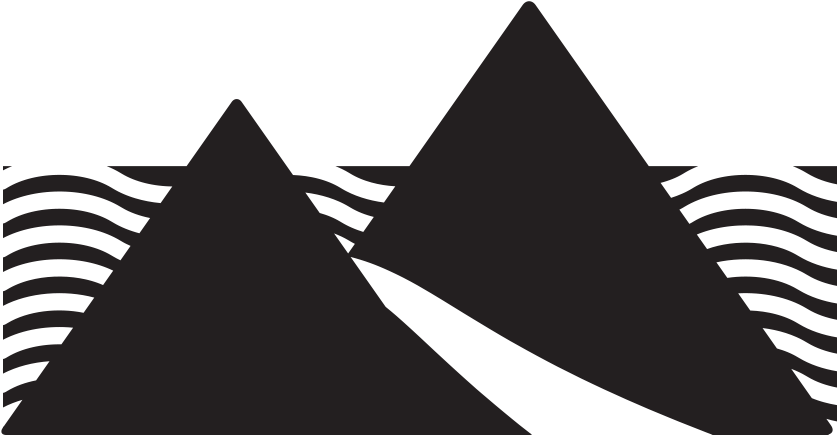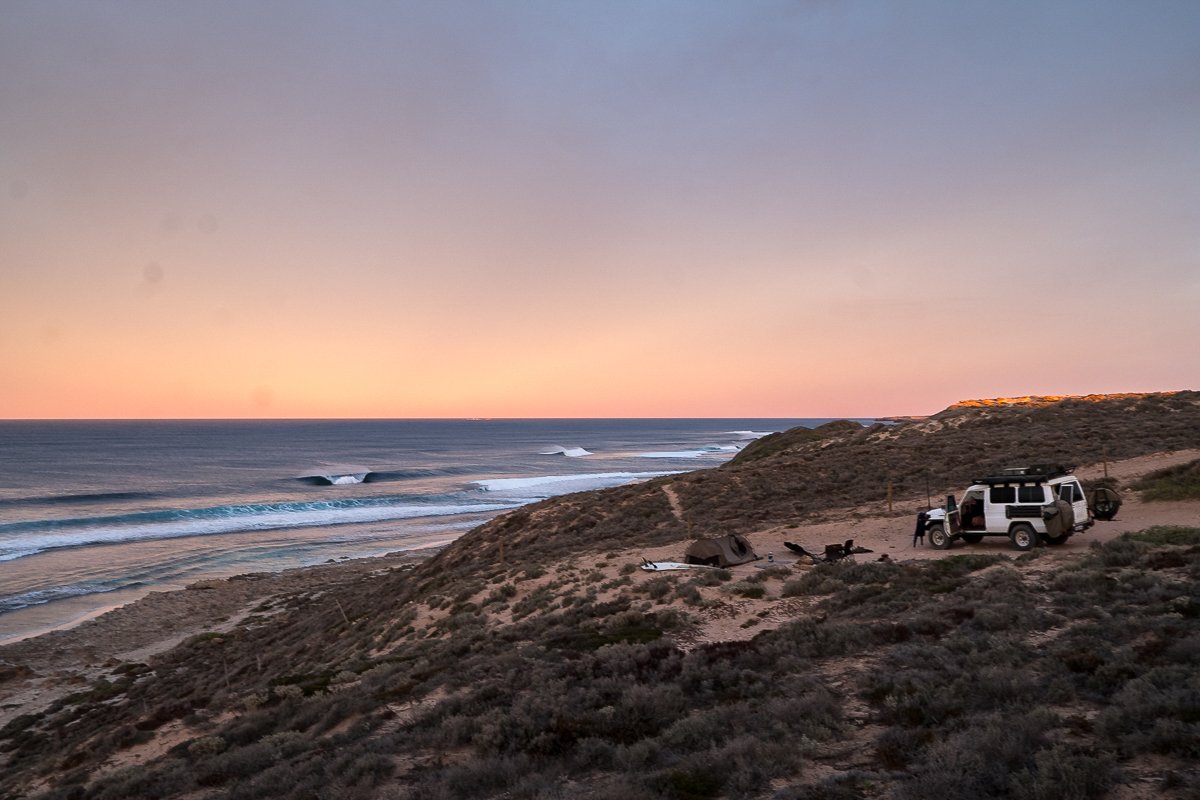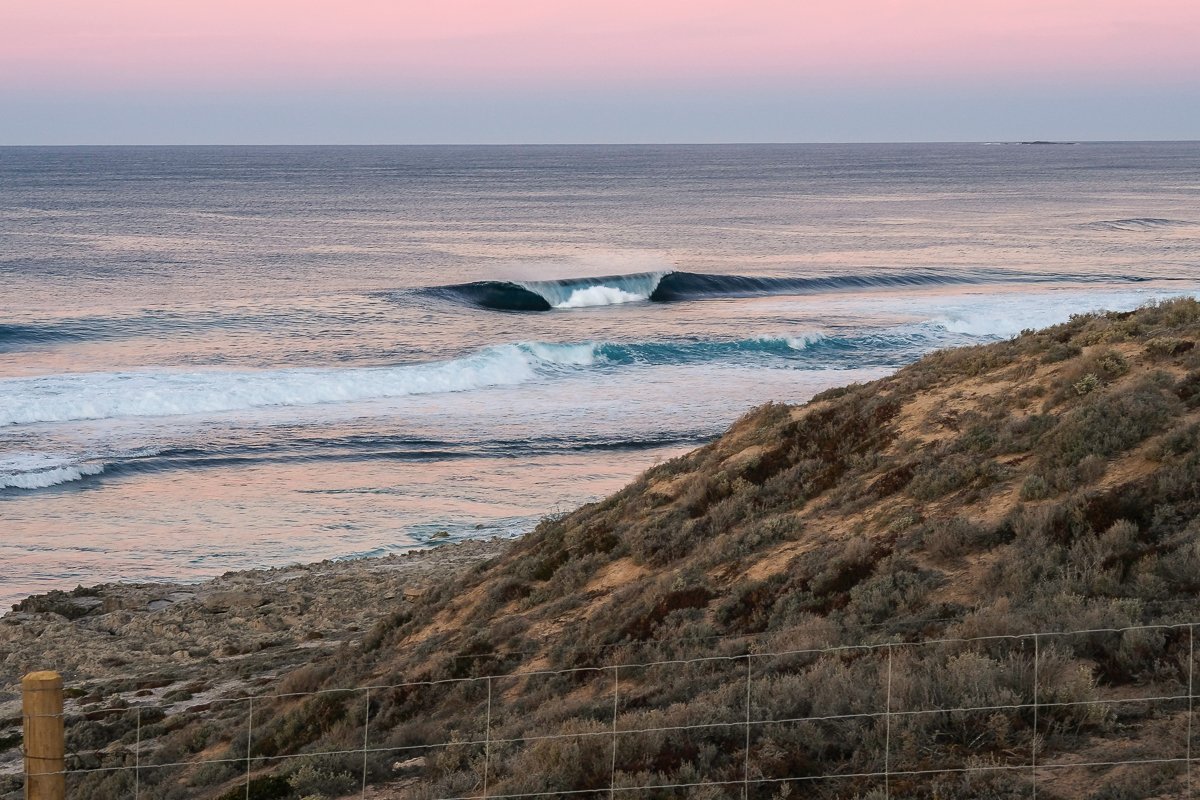Tony Bulke lives alone on a hill above a remote part of southern Australian coast. He is 68-years-old, unmarried, and has no kids, only two ten-year-old Golden Retrievers, Buddy and Lucy.
There are ten or so permanent residents in the blocks about Tony. Most of them live off-grid in half-finished houses, sheds, and caravans, and there are also a handful of holiday shacks and vacant blocks scattered about.
On one of those vacant blocks, which belongs to my mate Jason, I have had a camp set up for one month. The only facilities are a six by three metre lean-to, a 5000-litre rainwater tank, and a long drop toilet which looks out at the ocean.
Living quarters, wedged between desert and sea.
Like most of the other residents, I am here for the surf. The wind is incessant and the winter storms are growing in force, but this block is centred in one of the most wave rich zones in Australia.
I think I’ve been here too long now though because while this place might seem a surfing paradise at first, I am beginning to see a different side to it now. Isolated settlements like this can be bitter, cagey places to live, defined by small-town politics and gossip and suspicion.
“This might seem like a Utopia here, and in terms of surfing it is,” Tony tells me. “There is some of the best surf in the country, in the world here. Land is cheap too. But it is cheap for a reason.”
“There are almost no services here; the closest hospital is a four-hour drive away. You have to be careful who you associate with too. There are only a handful of us who live here full time but a lot of us don’t get along. If you’re seen talking to a person who somebody else doesn’t like, they might give you the cold shoulder next time they see you.”
Tony claims this part of the country also has some of the highest rates of mental illness and inbreeding per capita. There is no evidence to substantiate his claims, but Tony is insistent.
Tony plans to leave this place one day soon, but first he wants to finish his surfing career in some decent waves. His arthritis means he is slower to get to his feet so when he surfs now it is often with the assistance of a jet ski and his tow partner, Kev.
Their preferred wave is the bombie that sits two-kilometres offshore in the bay directly out front. It is a serious, hulking wave. Most who have surfed it regard it as one of the premier deep-water reef breaks in Australia.
It is through this wave that I first met Tony. From the distant view at my camp, I had been watching two teams surfing the break all morning. I wanted to join them, but I was nervous.
It wasn’t just because the waves were big and these waters are a renowned breeding ground for Great White sharks, but also because I didn’t know where to go. I didn’t know where to launch the boat, where to safely anchor it, where the line-up was, or how much longer the two tow teams already on it will stay out there for.
I was trying to summon some courage with a third coffee when Tony’s old, white Mitsubishi four-wheel-drive came clattering onto the block. His tanned, balding head peered out the window. His smile gleamed with silver fillings. His tow partner was away, he said, and he was looking for someone to surf with.
“I’m leaving right now,” he said. “You coming?”
Out past the shore break and the ribbon weed beds and the inner reefs, Tony showed me the boat mooring he dropped to the ocean floor just inside of the break.
“An old four-cylinder Mitsubishi engine block,” he says. “It’s got a heap of chain on it and plenty of rope too. Tie your boat up to that if you come out on your own.”
He introduced me to the tow team still out there and showed me the boils in the reef that line-up the break. He ran safety and shark patrol as I paddled into a handful of silky black eight-to-ten-feet peaks.
He seemed to get as much of a kick from watching me ride waves as he would riding them himself.
In the following weeks, Tony welcomed me into his home and his life. He helped me to rebuild the malfunctioning starter motor in my vehicle. He let my girlfriend use his shower and allowed me to make some repairs in his shed.
“Better you do it up here,” he says. “See my house, it’s got this wonderful thing called electricity.”
On one occasion, I left my boat at Tony’s house, planning to make some repairs to the trailer with him the following day. When I arrive at lunchtime, Tony has already fixed everything.
I’m surprised, because this coastline has a reputation for fierce, even violent localism, but it is men like Tony who give me faith in humanity. He is one of those extraordinary people who you meet in your travels, someone who appears in your life for only a fleeting moment but has a lasting impact.
Once Tony has helped me sort my vehicle and get back on the road, I wonder aloud to him why he has been so generous and helpful.
“Mate, I’ve travelled all around the world. Samoa, South Africa, Sumatra, Hawaii,” he says.
“And it’s always nice to know that there are still people out there who will actually help you when you’re stuck.”
From a place where the hardest decision to make each day is what surfboard to ride.
There are two signs on the track in to this remote beach, somewhere on Australia’s southern coast. One is a Border Watch notice advising you to report any suspicious activity. The other heeds a stark warning: AVOID GETTING BOGGED.
Me, my girlfriend, and our little old dog, Jezza, are about to drive up this 20km stretch of very soft and steep beach. We’ve heard whispers of a mythical right hander at the far end, if we can make it there. We follow a set of half-washed away vehicle tracks: second gear, low range, engine roaring, white knuckles on the steering wheel and buttocks firmly clenched on the seat.
Arriving at the headland, the surf is eight-to-ten feet. All of this raw Southern Ocean energy is focused into a bombie style peak, breaking just out from an exposed volcanic rock. Rounding the point, the waves reel 250m to the beach, breaking just clear of an exposed patch of granite. Near the final section there’s a huge shifting black patch of salmon and a seal frolicking in the white water.
I’ve found myself in a predicament that anyone who has surfed along Australia’s southern coast will understand. These are the kind of empty, pumping waves that we all dream of. But in an unfamiliar location, with no mates to get you frothing, no one to prove anything to but yourself, do you nelly up and paddle out? Or sit on the beach, making excuses while plagued with terror and self-disgust?
I set up a camp chair and make breakfast. I look through binoculars up the beach, hoping, praying that the flock of emus and every patch of weed up there is another vehicle carrying crew to surf with. I know I’m kidding myself. The tide is up. There’s no way out, and no one is coming.
It takes me a few hours but finally I work up the courage to put a wetsuit on. I’ve been secretly hoping that the wind will come in and the tide will rise and ruin it all, because if it wasn’t so pumping I wouldn’t feel so bad about not paddling out. But it’s pumping. There is no excuse.
The only way to paddle out is by jumping off the back of the headland. From here it’s a long paddle out and behind the break. I loiter by the waters edge, pussy footing from rock to rock. With one dumb, impulsive, foolish lurch, I find myself in the water.
As soon as I dunk my head under everything feels more fluid and natural. I try to focus on the waves, and the route I need to take, and not what might be lurking beneath me. I build a rhythm with every stroke. Surfing alone, with no hassle and no crowds, totally purifies the act.
With each lull between the sets I find myself running scenarios through my head, convincing myself that each little piece of wind chop is a big fin. Surfing alone is also emotionally exhausting; a real rollercoaster of fear of and triumph, and after just a handful of waves, I was done.
It is this fear that is at the heart of any adventure. Fear is one of the most basic, primal sensations. It is felt by all sentient beings, and humans respond to it in different ways. Some fight it, others flight it.
Personally, surfing helps me to be comfortable with fear. Because it is only when I’m afraid that I know I am truly alive.
Not far from this beach, and Tony’s place, relatively speaking, is an especially concentrated area of surf breaks. A promising surf forecast has us on our way there, driving well into the night. We turn off the highway and down a rough dusty road.
This place was once a well-guarded secret, rumoured to have been first surfed by local fisherman in the early 70s. For years it was kept under the radar, known only to the surfers living in frontier-type towns nearby and the odd pro.
Idyllic camp in Australia’s far south.
Today, there are 30 to 40 people camping on the cliffs and dunes overlooking the breaks. Some, like us, are travellers, resting up for a few days on their way through. Others have seen the forecast and jetted in from around the country, loading up airport rental cars with boards and beer and swags and mi-goreng and flagons of spring water.
Almost everyone here is in their twenties, except for one man. Eamon, a concreter in his forties from Ulladulla, occupies the camp beside us. His Landcruiser ute shields his pop-up tent from the prevailing wind. Arranged in the dirt are a camp chair and table, a Gas-Mate stove, a little 10-inch chain saw, and a big pile of mallee branches. Surfboards and plastic tubs are stacked in the back of his ute.
Eamon has been here almost a week, and he plans to stay for another if the waves keep up like this. His beard is stained with zinc and his eyes are red, bleary, unfocused. He, like everyone else here, has no mobile service and no link to the outside world. All that concerns him, he says, are the quality of the waves out front and the next meal he has to try and rustle up.
Eamon runs us through the list of dangers and discomforts here. There’s the dust, the wind, the isolation, lack of sanitation, the flies and the sharks and the angry, slabbing reef breaks.
But worst of all, he says, are the mice.
“They’re real bad, hey” he says.
“This morning I woke up and I actually thought it had been raining; there were all these little sprinkle-like patterns in the sand. ‘It can’t have been raining,’ I thought. I looked closer and they were actually mice prints. Every square inch of dirt in the camp was covered in them.
“They’ll get into everything. If it’s not them it’s the wind and the dust. The only real escape from it all is to go surfing.”
Eamon tells me he is tempted to buy a place out here. Land is cheap and he wouldn’t need much to make it liveable. Fifty grand and he could buy a block, build a shed, put up a couple of rainwater tanks, he says.
“Yeah, it probably would be pretty isolated. But what does that matter when you get to surf empty, pumping waves like this all the time?”
For the next week the surf just does not stop. The wind remains offshore, even glassy at times. Lines of groundswell just keep pouring in. A brace of hollow, a-frame peaks right out front spread the crowd, and anyway, most of us are happy to have a couple of mates to surf with.
On our fifth day, word spreads about the camp of an approaching storm. No one has any mobile service to correlate this but the sky tells the story. A low bank of cloud grows over the inland horizon. The wind begins to howl 30 knots, whipping up a sea of whitecaps and clouds of dust and surfboards and empty beer cans.
Everyone scurries to pack up and begin the long drive back home. The convoys of four-wheel-drives hurry out in clouds of dust. As we leave, I pass Eamon standing there on the cliff tops. He looks back, and waves. He turns back, stroking his beard, smiling, and facing all the empty surf breaks.





